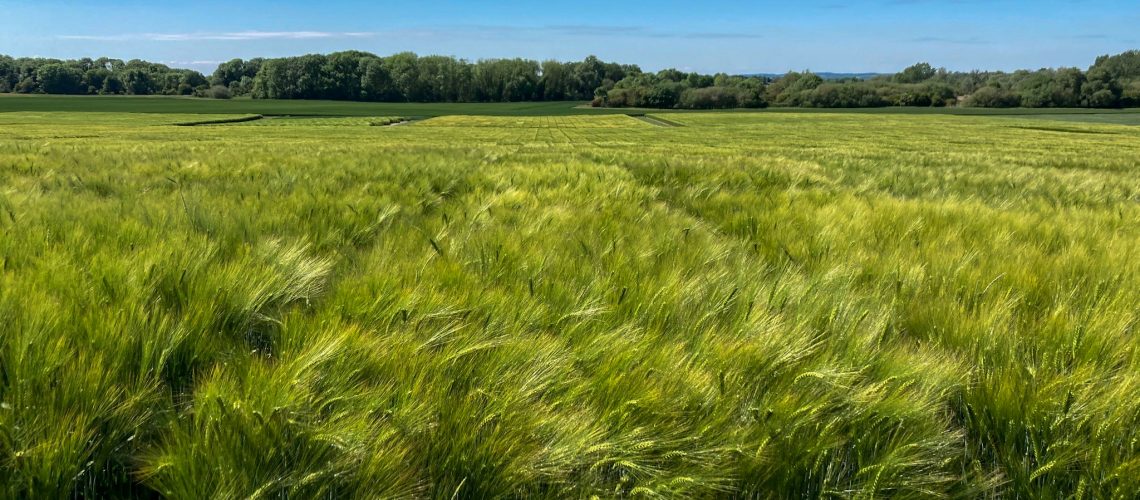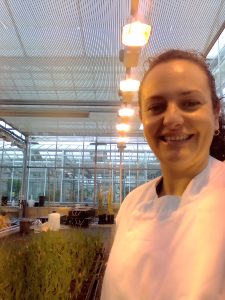

Carmen Escudero-Martinez
Post-doc MECEA Winner 2022
Unravelling the genetic relationships between cereals and their microbiome
- Post-doc MECEA Winner 2022
- | Part of MECEA
Cereals, like other plants, live in association with a myriad of microorganisms collectively referred to as the plant microbiome. These interactions are particularly dynamic in the rhizosphere, the thin interface between roots and soil1. The rhizosphere microbiome can provide cereals with “external traits” derived from the ability of these microbes to, for instance, gain access to mineral nutrients or protect the plants against pathogens2–5. The host plant is one of the drivers of the microbiome6,7, yet the genetic determinants underpinning microbial recruitment in the rhizosphere are not fully elucidated. This triggered my curiosity and made me realise the potential for discoveries investigating the genetic basis of these interactions in cereals.
One thing that caught my interest is the fact that wild and domesticated genotypes of the same crop host contrasting microbiomes8,9, a breakthrough linking the host genetic diversity with its associated microbes. Is then the microbiome associated with wild ancestors, which have evolved under marginal conditions, conferring an adaptive advantage to plants? Or, during domestication and crop selection, have breeders unintentionally retained the optimal plant microbe-combinations for plant growth in agricultural settings? If so, what kind of genes shaping the microbiome may have been selected for that? Barley, an important diploid crop10 with cutting-edge genomics11,12 and genetics resources13, represents an excellent model to investigate these plant-microbe interactions hypotheses8,14. I believed that research exploring the cereal microbiome for sustainable agriculture will be a successful one amid ongoing environmental changes and the need of decarbonising crop production in the years to come.
As the first step towards elucidating genes controlling the barley rhizosphere microbiota, we developed a novel approach that used microbial profiles as “external quantitative traits” in QTL mapping15. We detected barley QTLs for associations with rhizosphere bacteria in a segregating population between a wild and a domesticated barley genotype. One of these, the QTL for Rhizosphere Microbiota Composition which falls in the short arm of the 3H chromosome of barley, QRMC-3HS hereafter, was associated with the recruitment of diverse rhizosphere bacteria. The access to the latest genomic developments, as reference barley transcriptome12 and the pangenome information11, facilitate the selection of candidate genes at the QRMC-3HS locus. Exploiting these resources, root RNA-seq and variant calling were conducted on sibling lines harbouring contrasting alleles and displaying contrasting microbiotas at the QRMC-3HS locus. This served to advance the selection of candidate genes mapping at the locus of interest, among them, an immune receptor Nucleotide-Binding-Leucine-Rich-Repeat (NLR) highly expressed in the elite material. The most fascinating thing about this gene is that falls in a region of structural variation across the barley pangenome15. This indicates that the region has been under selection pressure, likely underlying an important agronomic trait. Whether the NLR is the gene triggering the observed microbiota shifts, the agronomic trait behind the structural variant, how deploying resistances may impact the plant-associated microbes, or which are the related microbial functions making up the barley “extended phenotype” are current lines of investigation.
The approach I followed to characterise the QRMC-3HS represents a paradigmatic example for the identification of host genetic drivers of rhizosphere microbes in crops and will set the stage for implementing microbiome science in plant breeding programs. These are exciting times for cereal microbiome research, we are on the verge of unlocking the full potential of the microbiome for sustainable crop production in barley and, possibly, other phylogenetically related species.
References:
1. Raaijmakers, J. M., Paulitz, T. C., Steinberg, C., Alabouvette, C. & Moënne-Loccoz, Y. The rhizosphere: a playground and battlefield for soilborne pathogens and beneficial microorganisms. Plant Soil 2008 3211 321, 341–361 (2008).
2. Berendsen, R. L. et al. Disease-induced assemblage of a plant-beneficial bacterial consortium. ISME J. 2018 126 12, 1496–1507 (2018).
3. Hacquard, S., Spaepen, S., Garrido-Oter, R. & Schulze-Lefert, P. Interplay Between Innate Immunity and the Plant Microbiota. Annu. Rev. Phytopathol. 55, 565–589 (2017).
4. Lu, T. et al. Rhizosphere microorganisms can influence the timing of plant flowering. Microbiome 6, (2018).
5. Verbon, E. H. & Liberman, L. M. Beneficial Microbes Affect Endogenous Mechanisms Controlling Root Development. Trends Plant Sci. 21, 218–229 (2016).
6. Bulgarelli, D. et al. Structure and Functions of the Bacterial Microbiota of Plants. (2013) doi:10.1146/annurev-arplant-050312-120106.
7. Hacquard, S. et al. Microbiota and host nutrition across plant and animal kingdoms. Cell Host Microbe 17, 603–616 (2015).
8. Davide Bulgarelli, A. et al. Structure and Function of the Bacterial Root Microbiota in Wild and Domesticated Barley Resource Structure and Function of the Bacterial Root Microbiota in Wild and Domesticated Barley. Cell Host Microbe 17, 392–403 (2015).
9. Pérez-Jaramillo, J. E. et al. Deciphering rhizosphere microbiome assembly of wild and modern common bean (Phaseolus vulgaris) in native and agricultural soils from Colombia. Microbiome 7, 1–16 (2019).
10. Newton, A. C. et al. Crops that feed the world 4. Barley: a resilient crop? Strengths and weaknesses in the context of food security. Food Secur. 2011 32 3, 141–178 (2011).
11. Jayakodi, M. et al. The barley pan-genome reveals the hidden legacy of mutation breeding. Nat. 2020 5887837 588, 284–289 (2020).
12. Coulter, M. et al. BaRTv2: A highly resolved barley reference transcriptome for accurate transcript-specific RNA-seq quantification. bioRxiv 2021.09.10.459729 (2021) doi:10.1101/2021.09.10.459729.
13. Maurer, A. et al. Modelling the genetic architecture of flowering time control in barley through nested association mapping. BMC Genomics 2015 161 16, 1–12 (2015).
14. Alegria Terrazas, R. et al. A footprint of plant eco-geographic adaptation on the composition of the barley rhizosphere bacterial microbiota. Sci. Reports 2020 101 10, 1–13 (2020).
15. Escudero-Martinez, C. et al. Identifying Plant Genes Shaping Microbiota Composition in the Barley Rhizosphere. bioRxiv 2021.12.20.472907 (2021) doi:10.1101/2021.12.20.472907.
